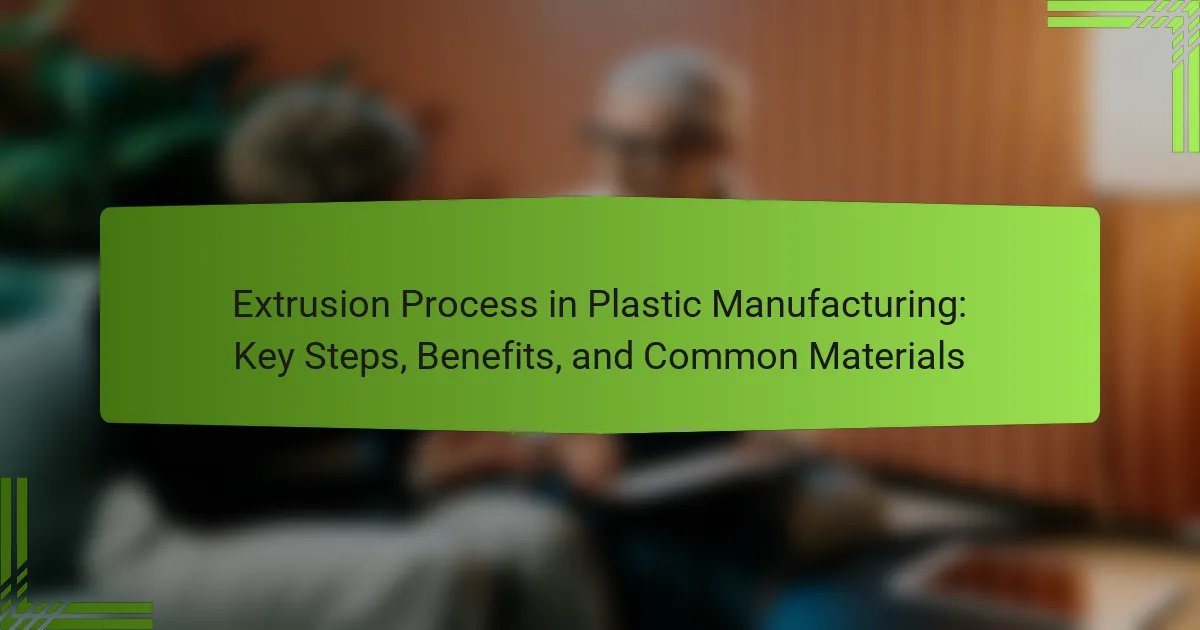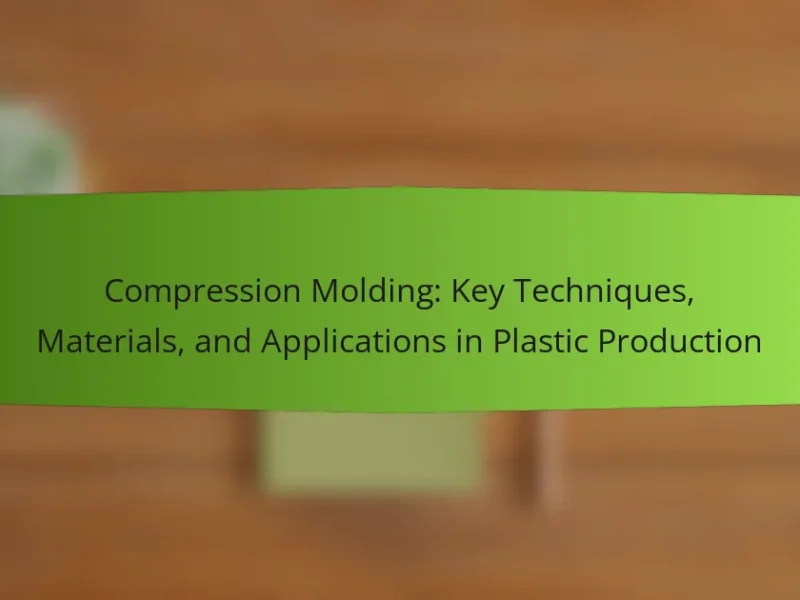The extrusion process in plastic manufacturing is a technique used to create continuous shapes from thermoplastic materials. This process involves feeding plastic pellets into a heated barrel, where they are melted and shaped through a die, producing items such as pipes, sheets, and films. Key materials used in extrusion include thermoplastics like polyethylene and polypropylene, thermosetting plastics such as epoxy, and metals like aluminum. Optimizing the extrusion process involves controlling temperature and pressure, utilizing high-quality raw materials, and implementing real-time monitoring systems to enhance productivity and product quality. Overall, the extrusion process is recognized for its efficiency, versatility, and cost-effectiveness in producing complex profiles.
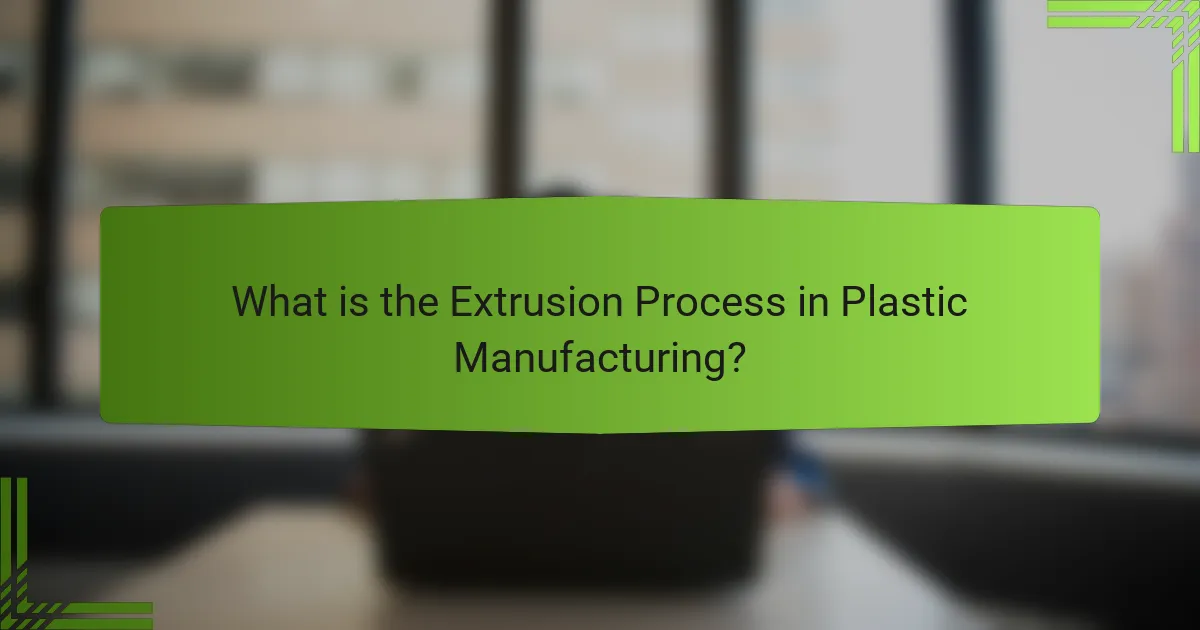
What is the Extrusion Process in Plastic Manufacturing?
The extrusion process in plastic manufacturing is a method used to create continuous shapes from thermoplastic materials. During this process, plastic pellets are fed into a heated barrel. The heat melts the plastic, which is then forced through a die to shape it into a desired profile. This technique allows for the production of items like pipes, sheets, and films. The extrusion process is efficient and can produce large quantities of products with consistent dimensions. It is widely used in various industries due to its versatility and cost-effectiveness.
How does the extrusion process work in plastic manufacturing?
The extrusion process in plastic manufacturing involves forcing plastic material through a shaped die to create continuous profiles. Initially, plastic pellets are fed into a hopper. The pellets then move into a heated barrel. In the barrel, they are melted by a combination of heat and mechanical shear from a rotating screw. Once melted, the plastic is pushed through the die, which shapes it into the desired form. After exiting the die, the extruded plastic is cooled and solidified, often using water or air. This process allows for high-volume production of uniform plastic shapes, such as pipes, sheets, and films. The extrusion process is widely used due to its efficiency and ability to produce complex profiles with precise dimensions.
What are the key components of the extrusion process?
The key components of the extrusion process include the extruder, material feed system, heating system, and die. The extruder is the primary machine that melts and shapes the material. The material feed system supplies raw materials, typically in pellet form, to the extruder. The heating system raises the temperature of the material to its melting point. The die shapes the molten material into the desired cross-section. These components work together to produce continuous lengths of extruded products. Each component plays a crucial role in ensuring the efficiency and quality of the extrusion process.
How does temperature affect the extrusion process?
Temperature significantly influences the extrusion process by affecting the viscosity of the material. Higher temperatures reduce viscosity, allowing for easier flow through the die. This can lead to improved material processing and reduced energy consumption. Conversely, lower temperatures increase viscosity, which can cause blockages and inconsistent product quality. Optimal temperature ranges vary depending on the material being extruded. For example, thermoplastics typically require specific temperature settings to achieve desired flow characteristics. Maintaining the correct temperature is crucial for achieving uniform extrusion and preventing defects.
What are the key steps involved in the extrusion process?
The key steps involved in the extrusion process are feeding, melting, extruding, cooling, and cutting. First, raw materials are fed into the extruder through a hopper. The materials then move through a heated barrel where they melt. Once melted, the material is forced through a die to shape it into the desired form. After shaping, the extrudate is cooled to solidify. Finally, the cooled product is cut to the required length for further processing or packaging. Each step is crucial for ensuring the quality and consistency of the final extruded product.
What is the role of material feeding in the extrusion process?
Material feeding is crucial in the extrusion process as it ensures a consistent supply of raw materials into the extruder. This process begins with the precise measurement of materials, which is essential for maintaining product quality. Proper feeding controls the flow rate and pressure within the extruder, facilitating uniform melting and mixing of materials.
Inadequate feeding can lead to fluctuations in material properties and defects in the final product. For instance, a study by the American Society of Plastics Engineers highlights that consistent material feeding improves the mechanical properties of extruded products. Therefore, effective material feeding directly influences the efficiency and quality of the extrusion process.
How is melting achieved during the extrusion process?
Melting during the extrusion process is achieved through heat and mechanical shear. The extrusion machine uses heaters to raise the temperature of the material, typically thermoplastics. This heating occurs in the barrel of the extruder. As the material is fed into the barrel, it encounters rotating screws. The rotation of the screws generates mechanical shear, which further increases the temperature. The combination of heat and shear causes the material to transition from a solid to a molten state. This melting process is crucial for shaping the material into the desired form during extrusion.
What happens during the shaping stage of the extrusion process?
During the shaping stage of the extrusion process, the material is forced through a die to create a specific cross-sectional shape. This stage involves the application of heat and pressure to soften the material, making it malleable. The softened material is then pushed through the die by a screw mechanism. As it exits the die, the material solidifies into the desired shape. The shaping stage is critical for determining the final product’s dimensions and properties. Accurate control of temperature and pressure ensures uniformity in the extruded product. This process is essential in producing various plastic products used in multiple industries.
How is cooling managed in the extrusion process?
Cooling in the extrusion process is managed through controlled temperature regulation. This involves using cooling baths or air cooling systems to solidify the extruded material. Cooling is essential to ensure dimensional stability and prevent warping. Typically, water or air is used as a cooling medium. The cooling rate can affect the final properties of the extrudate. For example, faster cooling can lead to increased rigidity. Conversely, slower cooling may enhance flexibility. Effective cooling management is crucial for maintaining product quality and performance.
What benefits does the extrusion process offer in plastic manufacturing?
The extrusion process in plastic manufacturing offers several benefits. It enables continuous production of uniform products. This method allows for high efficiency in manufacturing. Extrusion can produce complex shapes that are difficult to achieve with other methods. The process minimizes waste by using raw materials more effectively. It also allows for the incorporation of additives during production. This results in enhanced material properties. Additionally, extrusion is suitable for both thermoplastics and thermosetting plastics. Overall, these advantages contribute to lower production costs and improved product quality.
Why is the extrusion process cost-effective for production?
The extrusion process is cost-effective for production due to its high efficiency and low labor costs. It allows continuous production, minimizing downtime between batches. The process uses less material waste compared to other manufacturing methods. Extrusion can produce complex shapes in a single pass, reducing the need for secondary operations. High-speed production rates further enhance cost savings. Additionally, the energy consumption per unit produced is lower than many alternative processes. These factors collectively contribute to the overall cost-effectiveness of the extrusion process in plastic manufacturing.
How does the extrusion process enhance material efficiency?
The extrusion process enhances material efficiency by minimizing waste during production. In this process, raw materials are continuously fed into a heated barrel and transformed into a uniform shape. This continuous flow reduces off-cuts and excess material compared to traditional manufacturing methods. Extrusion also allows for precise control over dimensions, which ensures that the final product meets specifications without excess trimming. According to a study by Plastics Technology, extrusion can achieve material utilization rates exceeding 90%. This high efficiency contributes to lower production costs and reduced environmental impact.
What advantages does the extrusion process provide in terms of product consistency?
The extrusion process offers significant advantages in product consistency. It ensures uniformity in shape and size throughout the production run. This method allows for continuous production, minimizing variations between batches. The controlled temperature and pressure during extrusion contribute to consistent material properties. Additionally, the process enables precise control over the flow of materials. This results in a homogeneous mixture, leading to fewer defects. Studies indicate that extrusion can achieve tolerances as tight as ±0.1 mm. Overall, these factors enhance the reliability of the final product in plastic manufacturing.
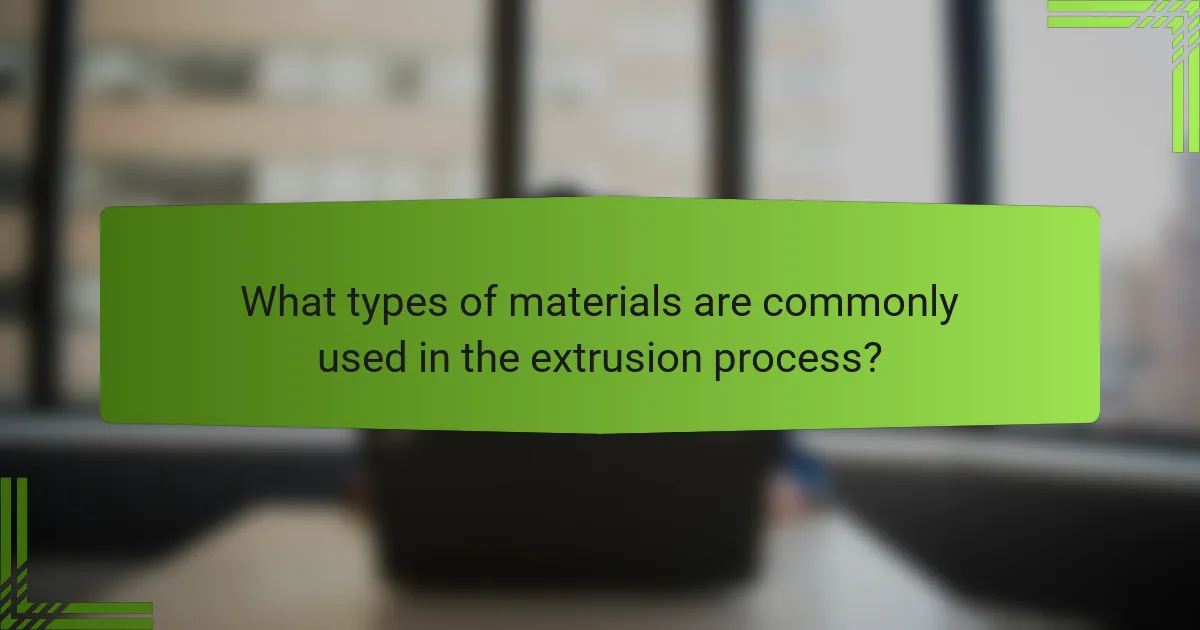
What types of materials are commonly used in the extrusion process?
Common materials used in the extrusion process include thermoplastics, thermosetting plastics, and metals. Thermoplastics such as polyethylene and polypropylene are widely utilized due to their versatility and ease of processing. Thermosetting plastics, like epoxy and phenolic resins, are used for their durability and heat resistance. Metals such as aluminum and copper can also be extruded for various applications. These materials are selected based on their flow characteristics and the desired properties of the final product. The extrusion process allows for the continuous shaping of these materials, making it efficient for producing complex profiles.
How do different materials affect the extrusion process?
Different materials significantly affect the extrusion process. Each material has unique properties that influence its flow behavior and processing parameters. For example, thermoplastics like polyethylene require lower temperatures for extrusion compared to thermosets. Their viscosity changes with temperature, affecting the ease of processing. Additionally, materials with higher molecular weights often exhibit greater resistance to flow, necessitating increased pressure during extrusion.
The presence of fillers or additives can also alter the material’s viscosity and thermal stability. For instance, adding glass fibers can enhance strength but may complicate the extrusion process. Different materials may require specific die designs to optimize flow and minimize defects.
In summary, the characteristics of materials, such as thermal properties and viscosity, directly impact the extrusion process efficiency and quality of the final product.
What are the characteristics of thermoplastics used in extrusion?
Thermoplastics used in extrusion possess several key characteristics. They can be repeatedly melted and reshaped without significant degradation. This allows for efficient processing and recycling. Thermoplastics exhibit good flow characteristics, enabling them to fill molds effectively during the extrusion process. They also have a wide range of temperature resistance, which varies by type. Common thermoplastics include polyethylene, polypropylene, and polystyrene. Each type has unique properties such as flexibility, strength, and chemical resistance. These attributes make thermoplastics suitable for various applications in the extrusion process. Their adaptability contributes to the versatility of products made through extrusion techniques.
How are thermosetting plastics utilized in the extrusion process?
Thermosetting plastics are utilized in the extrusion process by being heated and formed into specific shapes. During extrusion, these materials are mixed with additives and then subjected to high temperatures. This process causes the thermosetting plastics to undergo a chemical change, resulting in a hardened, durable product. Unlike thermoplastics, thermosetting plastics cannot be re-melted once cured. This characteristic makes them ideal for producing items that require high strength and thermal stability. Common applications include electrical insulators and automotive components, where durability is essential. The extrusion process allows for continuous production of complex shapes, enhancing manufacturing efficiency.
What are some common applications of the extrusion process?
The extrusion process is commonly used in various applications. It is widely utilized in the manufacturing of plastic products. Common applications include the production of pipes and tubing. The process also creates profiles for windows and doors. Additionally, it is used to make sheets and films. Food packaging often involves extruded materials. Automotive components frequently utilize extruded plastic parts. These applications highlight the versatility of the extrusion process in different industries.
How is the extrusion process used in packaging industries?
The extrusion process is widely used in packaging industries to create various plastic products. This process involves forcing melted plastic through a die to form continuous shapes. Common products include films, sheets, and containers. The extrusion method allows for high-volume production with consistent quality. Materials such as polyethylene and polypropylene are frequently used in this process. Extruded packaging is lightweight and can be tailored for specific applications. The versatility of extrusion supports innovations in sustainable packaging solutions. Overall, extrusion enhances efficiency and reduces material waste in packaging manufacturing.
What role does the extrusion process play in construction materials?
The extrusion process is essential in the production of various construction materials. It allows for the continuous shaping of materials, such as plastics and metals, into specific profiles. This process enhances the efficiency of manufacturing by reducing waste and enabling mass production. Extruded materials often exhibit improved strength and durability. Common construction materials produced through extrusion include pipes, window frames, and insulation panels. The extrusion process also allows for customization in size and shape, meeting specific building requirements. Furthermore, it enables the incorporation of additives for enhanced performance. Overall, extrusion plays a pivotal role in modern construction material manufacturing.
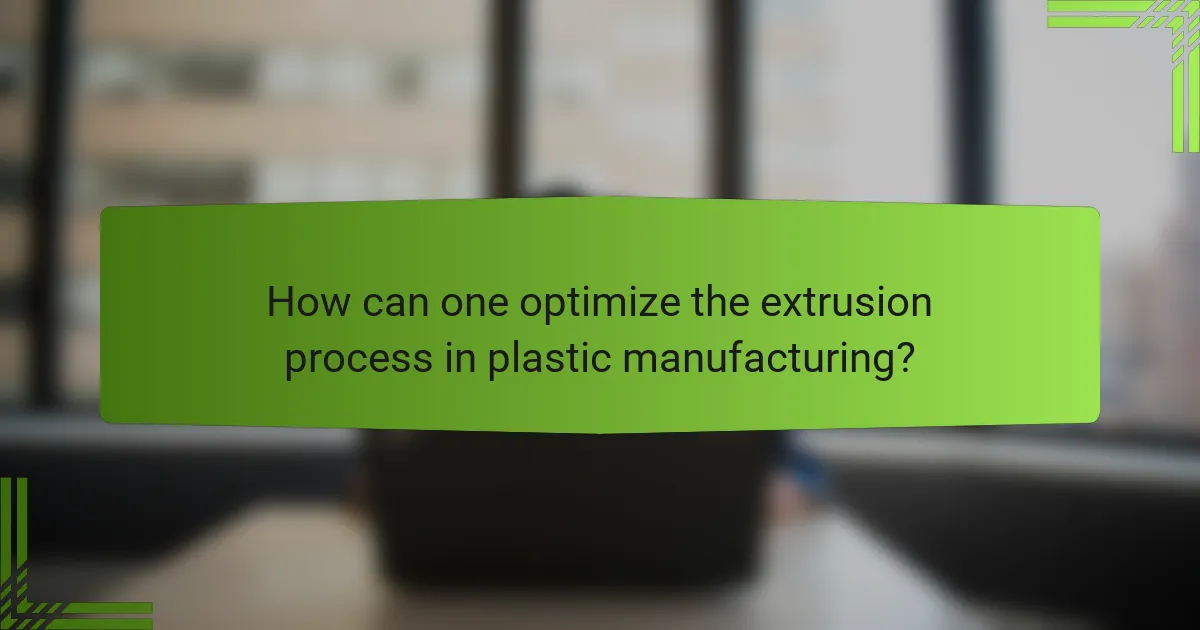
How can one optimize the extrusion process in plastic manufacturing?
To optimize the extrusion process in plastic manufacturing, one should focus on controlling temperature and pressure. Maintaining consistent temperature ensures uniform material flow. Pressure optimization reduces defects and enhances product quality. Additionally, using high-quality raw materials improves the extrusion output. Regular maintenance of equipment minimizes downtime and operational issues. Implementing real-time monitoring systems allows for immediate adjustments during the process. Training operators on best practices enhances efficiency and reduces errors. These strategies collectively lead to improved productivity and product consistency in plastic extrusion.
What best practices should be followed for effective extrusion?
Effective extrusion requires precise control of temperature, pressure, and material feed rate. Maintaining optimal temperature prevents degradation of the material. Consistent pressure ensures uniform flow through the die. Accurate material feed rate contributes to product quality. Regular maintenance of equipment reduces downtime and improves efficiency. Using high-quality raw materials enhances the final product’s properties. Implementing proper die design minimizes defects and improves output consistency. Monitoring the extrusion process in real-time allows for immediate adjustments to maintain quality.
How can material selection impact the extrusion outcome?
Material selection significantly impacts the extrusion outcome. Different materials exhibit varying flow characteristics during the extrusion process. For example, thermoplastics like polyethylene flow easily, resulting in smoother extrusions. In contrast, materials with higher viscosity can lead to increased pressure in the extruder. This pressure can cause defects such as die swell or uneven thickness. The thermal properties of the selected material also affect processing temperatures. Higher melting points require more energy and time, influencing production efficiency. Additionally, the chosen material’s compatibility with additives can alter the final product’s properties. Therefore, careful material selection is crucial for achieving desired extrusion quality and performance.
What maintenance tips can improve extrusion machine performance?
Regular maintenance can significantly improve extrusion machine performance. First, ensure that all components are clean and free from debris. This prevents blockages and allows for smooth operation. Next, regularly check and calibrate temperature settings. Proper temperature control is crucial for material consistency. Additionally, lubricate moving parts frequently to reduce friction and wear. Inspect the screw and barrel for signs of wear or damage. Replacing worn components can prevent breakdowns. Lastly, maintain a consistent schedule for preventive maintenance checks. This proactive approach minimizes downtime and enhances overall efficiency.
The extrusion process in plastic manufacturing is a method for creating continuous shapes from thermoplastic materials through a series of key steps, including feeding, melting, extruding, cooling, and cutting. This process is characterized by its efficiency, cost-effectiveness, and ability to produce complex profiles with consistent dimensions, making it widely applicable in various industries. Key components of the extrusion process include the extruder, material feed system, heating system, and die, all of which play vital roles in ensuring product quality. The article also explores the impact of temperature on extrusion, the advantages of using thermoplastics and thermosetting plastics, and common applications in sectors such as packaging and construction.
